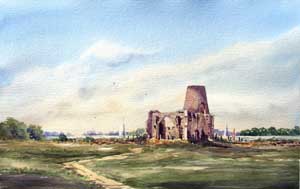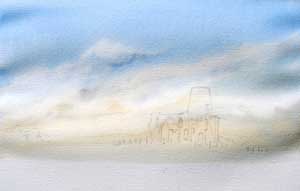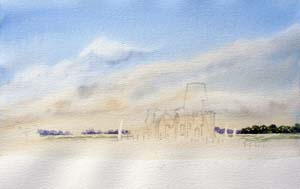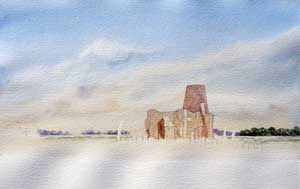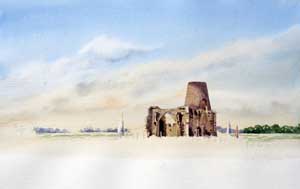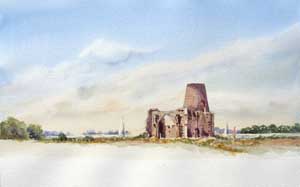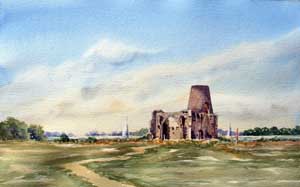|
|
As you can see
from my basic outline drawing, very very simple, no shading or
crosshatching. For my sky wash I have used my 1.5" wash brush pre wetting the
entire sky area and then going in with a mixture of yellow ochre and
light red in the bottom areas of the sky.
Then cobalt blue from the top all the way down and wash out my brush,
squeeze it out and with a damp brush suck out some clouds. Finally a
little bit of cobalt blue mixed with light red for some cloud shadow.
Notice that the clouds are coming up slightly diagonally, it gives us
little more movement to the sky. |
For my distant trees,
with my No.8 round brush, I use a mixture of cobalt blue and light red
dropping it in nice and weak. For the stuff to the right-hand to the
tree line, a mixture of Hooker's green and yellow ochre, which is a weaker
green. Then drop in a few touches of cobalt blue at the base of this
bunch to give it a little bit more depth. Notice at this stage that even
though all my paints have dried because obviously Iím painting out on
location in the sun, I can still use my ĺ" wash brush lightly damp and
suck out a few bits of paint to give me the mast of the yachts that
were sailing by behind.
Underneath of all these trees still with my ĺ" wash brush, I use a very
weak yellow ochre and put a couple of swaths of cornfields and whilst
this was still wet pop in a little bit of Hooker's green and yellow ochre
mixed here and there. |
|
|
|
For the tower
of the abbey, which was incidentally was a bit of an old windmill, I used
a mix of raw umber mixed with light red and my No.8 round brush. Notice
I have kept the paint weaker at one side than the other, this is to
capture a little bit of light at the very beginning. For the old stonework
part of the abbey, I have used the Charles Evans sand mixed with a
tiny hint of light red, nice and weak and fill it all in. Donít fiddle
about at this stage.
Notice I have now filled in the sails, a little bit of cobalt blue and a
tint of light red. White in shadow is not white, it has a blue tinge. One
of these sails I have painted red, and no thatís not red sails in the
sunset, itís a bit of an old Norfolk yacht sail colour. |
|
It is time to give
that building some real depth and for this Iím using my shadow colour
which is cobalt blue, alizarin crimson and burnt sienna. Now always
remember to keep the light coming from the same side, and in this
painting the light is coming from the left, so using my No.8 round brush
get some stronger shadows, then some weaker shadows by adding some more
water to the mix. |
|
|
|
Notice in the tower part of the abbey, the shadow is curling around,
starting from the top left going around down the right-hand side. This
gives a feeling of a roundedness. Donít forget to put some shadows on
inside of the building as well as you can see through the archway.
|
For the rough grasses
underneath the abbey and coming out to the left Iíve used my ĺ" wash
brush. Donít fiddle about with this, itís a few strokes of yellow ochre
well watered down, then a little bit of Hooker's green and yellow ochre
mixed, then a few tiny hints of light red (applied sparingly). A few
flicks in an upward motion will give me some tufts of grass and for the
bush on the extreme left-hand side, Iíve still kept to the same brush
with yellow ochre first of all, then Hooker's green and burnt sienna on
top of this will give me a bush.
Coming further forward Iíve used my ĺ" wash brush, very loosely, apply
some well watered down yellow ochre followed by Hooker's green and burnt
sienna mixed. Keep it all loose and wet, let the colours run into each
other and for the path, using the same brush and a mixture of the
Charles Evans sand colour with a tiny touch of raw umber. Donít mess
with it, just fill it in. |
|
|
|
Finally, Iíve added a
little bit of the same Hooker's green mix down the centre of the path
before adding my shadows which is a mixture of cobalt blue, alizarin
crimson and burnt sienna, apply sparingly, but be brave. When you add
this colour, if you mess about youíll disturb the colours underneath,
the result, mixing mud on the paper. Do quick, loose brush strokes
instead.
There we go, one of my favourite Norfolk scenes, because this sums up
Norfolk to me and it is a scene that was painted many times by one of my
greatest heroes Edward Seago. Hope you enjoyed this one and remember
when painting outdoors on location, paint quicker. |

